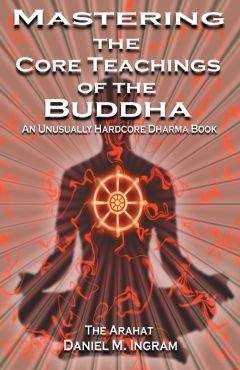Daniel Ingram - Mastering the Core Teachings of Buddha - An Unusually Hardcore Dharma Book
На сайте mybooks.club вы можете бесплатно читать книги онлайн без регистрации, включая Daniel Ingram - Mastering the Core Teachings of Buddha - An Unusually Hardcore Dharma Book. Жанр: Прочее издательство -,. Доступна полная версия книги с кратким содержанием для предварительного ознакомления, аннотацией (предисловием), рецензиями от других читателей и их экспертным мнением.
Кроме того, на сайте mybooks.club вы найдете множество новинок, которые стоит прочитать.

Daniel Ingram - Mastering the Core Teachings of Buddha - An Unusually Hardcore Dharma Book краткое содержание
Mastering the Core Teachings of Buddha - An Unusually Hardcore Dharma Book читать онлайн бесплатно
This complex sphere on which was unfolding more and more
complex patterns would then shift to something far more inclusive of space and the center of attention, thus becoming much more three dimensional. At this point, things seemed to happen on their own, but in a silent, clear, all encompassing way that was way beyond the second jhana, and this marks the entrance to the fourth vipassana jhana.
As things would organize, there would arise all sorts of images, from Buddhas to black holes, from brilliantly formed Tantric images (Vajrasattva with consort, etc.) to complex abstract, three dimensional designs that included the whole field of attention, with all made of rainbow lines, luminous, living, and very clear. I could end the cycle with essentially any image I wished with an ease I had never previously achieved. If I had not previously determined an image to end with, the surprises were just as good as anything I came up with and sometimes better. The point is that if you get your concentration strong enough, you can do these things also.
Shortly after the clear image would arise, attention would shift to include the fundamental characteristics of the whole thing at level that was perfectly inclusive of what ordinarily would be called subject and object, and Fruition would arise as the whole thing vanished through one of the Three Doors, but with a clarity that is rare. Then I would open my eyes, stare at the flame, and do it all again. Each cycle took about 10-15 minutes, but I could linger in each stage for longer if I consciously resisted the pull to move onward.
While obviously this example involves very clean samatha-like images, very strong concentration, and was done by an advanced practitioner under relatively special conditions, this candle flame 223
The Vipassana Jhanas
technique can be very interesting, and in classes I have taught some were able to quickly get to the later jhanas without too much time or effort. Some people just seem to have a natural ability to visualize, or focus on a mantra, or some other object, and it makes a lot of sense of draw on these natural tendencies. It can also be fun to develop these fronts even if this is not your strong suit, as it helps expand the range of your practice. Thus, consider playing around with using other objects and focuses at times, as they can bring different perspectives.
To give another example, using a different object, if one is using a mantra, one may notice that at some point one shifts to being able to stay with mantra clearly and perceive it as an object, which is the first jhana, starting with Mind and Body. Once the mantra is clear, one may notice all sorts of things about the process of mentally creating the mantra, such as the stream of intentions being followed shortly behind by the string of the mantra itself follow slightly behind by the mental echo of the perception of the mantra, making what appear to be three separate streams of the mantra. This is direct insight into Cause and Effect, and as the Three Characteristics of each of these streams become clear, the first jhana matures.
Then the mantra will shift to presenting itself, and will become very clear, as if it is reciting itself. This is obviously the second jhana, and one may experience A&P-like phenomena around here. As the practitioner shifts into the third jhana, the mantra gets wide in the stereo field, complex, with interesting harmonies if one is so inclined, and yet it may seem to be out of phase with attention or it may seem distorted, annoying, like something that was once beautiful has become noisy.
One may experience Dark Night-related phenomena in this phase. As the shift to the fourth jhana comes, the mantra may become part of a very wide, more quite background, as attention becomes inclusive.
Other fourth jhana-like or high equanimity-like phenomena may occur around here.
Thus, the vipassana jhana model can really help people line up experiences across objects, traditions, and practitioners, as they get to the common ground of spiritual terrain in a more fundamental way than the ñanas may, as those with strong concentration abilities may dodge a lot of the emotional side effects that are emphasized by that map, and 224
The Vipassana Jhanas
those using different objects may have such seemingly different pathways. However, now that you know the vipassana jhanas, if you practice well or ask good questions of those you speak with, you should have a much easier time of lining things up and making sense of things.
Another thing that can help is noticing that each jhana has its smaller aspects that can be classified in a manner different from the ñanas, and here I refer to what Bill labeled the sub-jhanas. As I mentioned on the section on the samatha jhanas, each jhana, vipassana or otherwise, has its sub-phases. Initially, the jhana is new, fresh, clear, but perhaps a bit unsteady as the mind gets used to it (first sub-jhana), then it really comes into its own (second sub-jhana), then the flaws and limits of the jhana are perceived (third sub-jhana), then there is some sort of balanced synthesis of these that at once allows the flaw and begins to incorporate the pull towards that which comes next (fourth sub-jhana).
In this way, it is possible to see models within models within models, and if you practice long and clearly enough with the models in mind you will run into this aspect of things. The warnings about the problems with the models go ten times or more for the sub-jhana models and deeper fractal theories of meditation terrain. They are a largely endless subject whose usefulness is debatable and whose perils are well known.
Consider yourself duly warned!
FRACTALS
Unfortunately, I somehow am not able to keep myself from
presenting just a few of the basics of fractal theory here, particularly as it relates to Bill’s model. There is also something exceedingly universal about the pattern that I am about to present, and resonances of it are found back as far as there is recorded human history, religion and art.
If you consider the first 360 degrees of a sine wave (like a rounded capital italic “N” that has been tilted just a bit to the right), you will notice that is starts at zero, goes up in a hill-like way, peaks, descends below where it started in a valley-like way, bottoms out, and then returns to the same level at which it began but yet farther along.
Were one walking on this curve, one would have to make effort to climb up the hill. One would then have a spectacular view and a great sense of accomplishment. One might then try to keep walking up to get more of this, but end up sliding down the other side of the hill, farther 225
The Vipassana Jhanas
down in fact than where one began. And yet, this is still progress, and could even be somewhat thrilling and even effortless with the right attitude. Just when one gets to the very bottom, trapped in the darkest part of the pit, by finally coming to rest at the absolute bottom the upward motion begins to happen naturally, and one returns to where one was, ground zero, and yet farther on at the same time. A cycle is complete and yet begins again endlessly.
This easily correlates with the first four vipassana jhanas, as well as many other obvious cycles such as those of the sun and seasons, etc. For those trying to correlate the maps of the progress of insight with those of Tantra’s Five Buddha Families or those of any number of pagan and nature-based traditions, this should prove most helpful. The first vipassana jhana is climbing up the hill, eager beginnings, hard work, dawn, Spring, East, etc. The second vipassana jhana is the giddy high of accomplishment at the top of the hill, high noon, Summer, South, etc.
The third vipassana jhana is the exhilarating and yet scary fall far down the other side into a cool and shadowy valley, dusk and nightfall, Autumn, West, etc. The fourth vipassana jhana is coming to rest regardless of where one is and returning to one’s origin naturally, the cool of the dead of night and early morning, Winter and the promise of Springtime, the coming of a new year at the end of the old, a time of rest, completion and renewal, North. The correlations with the stages of insight are thus obvious. One may also correlate this with some of the models of awakening, particularly the Four Path Model and the Simple Model of awakening, both of which will be explained later.
Interestingly, one may begin to see a full cycle of each of these stages in each of the four vipassana jhanas as well, with each peak and valley adding or subtracting from the position of the greater wave it is an aspect of. For all you incurable model geeks, try plotting y=sin(x)+0.25*sin(4x) from x=0 to 2π on a graphing program. You have my sympathy. The x-axis is the jhanas and sub-jhanas, from 1.1 to 4.4, or 1.1.1 to 4.4.4 if you want to go into sub-sub-jhanas. Unfortunately, what goes on the y-axis would be the subject of a book longer than this one and would read like the most difficult works of Aleister Crowley. In short, the possible complexity of this model is endless and it is no substitute for practice.
226
The Vipassana Jhanas
Try not to become an arrogant twit like I did when I began to figure all this stuff out. Esoteric map theory won’t win you any friends.
I have spent way too much time thinking about the fractals and modeling in my own practice. In my insecure moments, I have
considered showing off and writing a book that detailed the hundreds of little parallels and patterns that I have noticed over the years, how this tiny little stage of some vipassana sub-jhana mirrored or was in inversion of another aspect of some other little stage of some other sub-sub-jhana, but I couldn’t come up with any practical use for it at all. If you do the technique, you will see all of this and more. If not, reading about it won’t help you. It’s just another content trap, but a seductive one for us pseudo-intellectuals. On the other hand, Khabbala seems to have made related permutations into meditation itself, and those who are particularly inclined to this sort of analysis might want to try taking it as a vehicle for going beyond it. Also, guess where the complex geometric Tibetan Mandalas that are supposed to be pictures of the Mind or the Universe come from? Bingo!
U PANDITA’S MODEL
U Pandita, one of the greatest modern masters of meditation in the Burmese Theravada tradition (see his work In This Very Life) doesn't quite agree with Bill and I about how the ñanas and jhana line up, and so I thought that in the interest of fairness I would present his model .
In his model, as in Bill's model, the first three stages of Mind and Body, Cause and Effect, and The Three Characteristics all fall within the first vipassana jhana. However, he divides the Arising and Passing Away into two jhanas, with the immature phase (when the meditator is still in the grip of the Ten Corruptions of Insight) corresponding to the second jhana and the mature phase (when the meditator sees the true nature of the Ten Corruptions of Insight and crosses the A&P Event) as the third jhana. Everything from Dissolution to Equanimity then falls into the fourth jhana in his model. This does accommodate the vague formless experiences that can happen in Dissolution, as the formless realms come out of the fourth jhana.
The problem with this map is similar to the problem with the other maps, namely that some of the stages of insight tend to suck and the samatha or pure concentration jhanas are always a good time or 227
The Vipassana Jhanas
peaceful. Thus, to say that the Dark Night stages such as Disgust are part of the fourth jhana just rubs the wrong way somehow, as does saying that Three Characteristics (which also tends to suck a bit) is part of the enjoyable first jhana. The point is that no matter how you slice it, the correlations are not quite perfect, and insight practice is rarely as pleasant as good old concentration practices. That said, there is something to these models anyway, and if you master insight and concentration practices and know a bit of theory, you will see for yourself what they were trying to get at, so get to it!
INKLINGS OF ONE MORE MODEL
The last model is one that is hinted at by the a line in The Vi
suddhimagga when it says that Desire for Deliverance, Re-observation and Equanimity are one. This cryptic phrase may mean many things.
One of them is that the content of these three stages is likely to be largely the same, while the relationship to it may change dramatically. It could also be used as justification for a third model that put these three together in the fourth jhana. Further, as the fourth vipassana jhana is about equanimity concerning formations, one might presume that one would have had to perceive formations at an earlier stage, such as the previous two, in order to have had the necessary time and experience to come to equanimity concerning them.
Go see for yourself and consider which of these three models presented here fits with your actual experience, or throw this book and all of its models out the window and investigate the Three
Characteristics precisely regardless of what happens! Actually, such decisions might be better made after reading the next chapter…
228
Mastering the Core Teachings of the Buddha
26.HOW THE MAPS HELP
Now that I have presented the maps of the Progress of Insight, I will reiterate just a bit about how they help and why I went to all of that trouble. I will try to do this in chronological sequence and tie it in with what has been said in Part I.
The maps tell you clearly what you are looking for and explain exactly and precisely why you are looking for it, how that insight helps, and how that insight provides the ground for what follows. The same thing could be said of the concentration state maps. If the stages of insight didn’t tend to bring up all sorts of unusual raptures and produce such a wide range of potentially destabilizing emotional side effects, there would not be so much need for the maps. You could simply tell people to increase their perceptual abilities until they got enlightened, and they would likely have few difficulties in doing so by properly applying the techniques. However, the insight stages do tend to cause these sorts of effects, so the maps are very useful for keeping people on track in the face of them.
Remember long ago in the chapter called The Seven Factors of Enlightenment when I mentioned that the first factor was mindfulness and that this was really good for sorting out what is mind and what is body and when each is and isn't there? That is because the first insight you are looking for, the one that gets you in a position to see more deeply, is stage 1. Mind and Body. Get it? This stuff is not random or arbitrary. It is all clearly laid out in a way that helps and fits with reality.
Remember how I said in that chapter that one should try to
experience the intentions that precede actions and thoughts, as well as the mental impression or “consciousness” that follows all sensations?
That is the understanding in stage 2. Cause and Effect. Thus, mindfulness is the first factor of enlightenment because it leads directly to the first two classic insights into the truth of what is actually going on.
If you want insight into something, then looking into that aspect of things precisely is the best way to acquire that insight.
Once one has directly experienced these two insights, then the Three Characteristics begin to become obvious in stage 3. The Three Characteristics, which is exactly why the next factor of enlightenment is
Похожие книги на "Mastering the Core Teachings of Buddha - An Unusually Hardcore Dharma Book", Daniel Ingram
Daniel Ingram читать все книги автора по порядку
Daniel Ingram - все книги автора в одном месте читать по порядку полные версии на сайте онлайн библиотеки mybooks.club.




